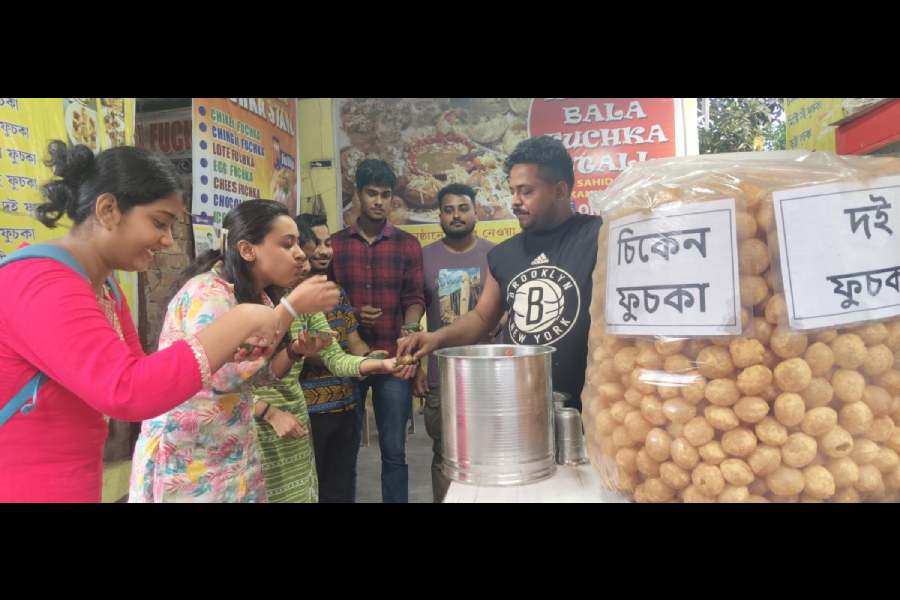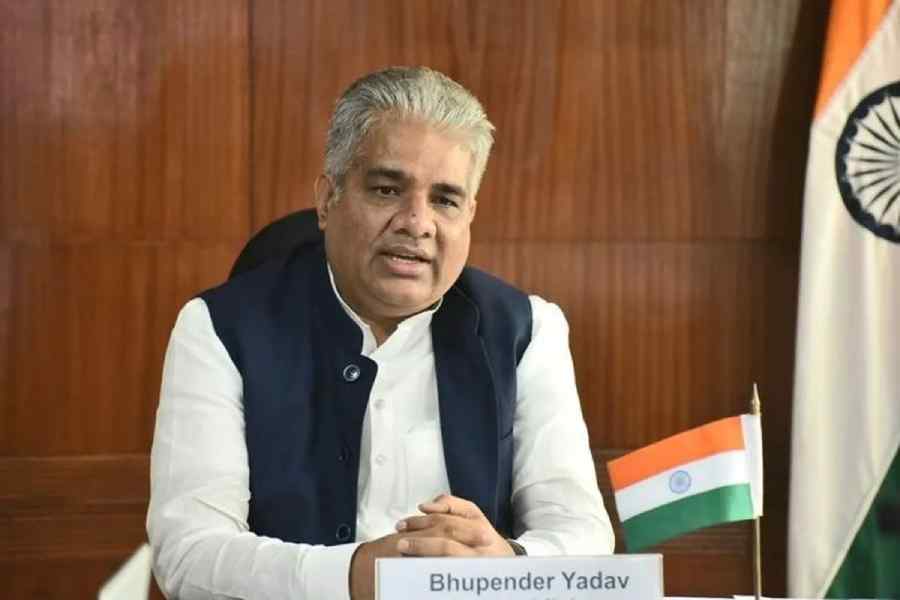Annapurna Fuchka Stall, Tiyasha Fuchka Stall, Rishi Bala Fuchka Stall, Fuchka Point, Ranjit Bala Fuchka Stall, Tumpa Fuchka Stall, Ma Tara Fuchka Stall...
Those would be the rows of shops you see when you enter Kanchrapara’s Shahid Pally and the signages atop them.
Shahid Pally is 60 kilometres north of Calcutta. Every shop has a list of the varieties of fuchkas it specialises in. Chicken fuchka, prawn fuchka, loitya fuchka, pomfret fuchka, bhetki fuchka, mutton fuchka, mango fuchka, strawberry ice cream fuchka, jelly fuchka, chocolate fuchka, Nabadwiper doi fuchka…
To a die-hard fuchka or golgappa fan, the concoctions sound outlandish. After all, what is a fuchka but an airy ball made from deep frying finely rolled dough of equal portions of flour and semolina with a dash of baking soda. It is served with a filling of potato mashed with spices and doused in tamarind water. Some might add a sweet chutney to it, some have it with raw mango or pudina water, but that’s about it.
Balai Gayen, 62, a resident of this area, is said to be behind this transformation of Shahid Pally. He doesn’t pretend to understand all of the varieties the newer generation of fuchka entrepreneurs have introduced, but he is happy with the brisk business they bring in.

“It was a little different when I started out in this line of business 32 years ago,” he says while packing fuchkas into huge plastic sacks and loading them on to totos. Each sack has 2,000 fuchkas. “My sons and I fry 35,000 to 40,000 fuchkas every day,” he tells The Telegraph.
Shahid Pally alone meets the fuchka demand of a clutch of small towns in Bengal and also certain neighbourhoods in Calcutta. Once done, Balai sits down to narrate his story.
In the 1990s, says Balai, Shahid Pally looked different. The people were decently off even then; after all, it was part of an industrial belt. The Kanchrapara Railway Workshop was close by. There was also half a dozen brick kilns in the area. More than half the population was employed in these two places. The rest stuck to their traditional job, which is fishing. Shahid Pally, after all, is situated on a riverine island on the Bhagirathi river.
Balai himself used to weave jamdani saris. He says, “I had 28 looms. There was a score of labourers working for me. I used to sell saris to traders in Phulia town in this very district.” Phulia is famed for being a hub for handloom saris.
He continues, “Those days, there were a couple of families of migrant labourers from Bihar living here. In the evening, the women used to put up fuchka stalls.”
Someone told Balai that making fuchkas and selling them to wholesalers was a low-investment business with high returns. So when he had a falling out with his partner and quit the jamdani business altogether, he learnt to make fuchkas from a person in Ranaghat. “I became quite good at it,” says Balai.
Ranjit Bala, 32, is busy frying fuchkas on the top floor of his three-storeyed house. In the courtyard, under a tarpaulin shade, his father and a few women are also frying fuchkas. “I do not have time to talk. I have to deliver 40,000 fuchkas by noon today,” said his father and turned away. “My father was a fisherman,” says Ranjit. But clearly that was not Ranjit’s chosen profession.
His daily routine is fixed. From seven to noon, he fries fuchkas. There are four women who work for him, all residents of Shahid Pally. His immediate and extended family is also involved in this business.
They send their fuchkas to Ranaghat, Naihati, Bandel, Tribeni, Kanchrapara, Howrah, Sealdah, Baguiati, Kestopur, Behala. It is the same story for almost all the 200 families living in Shahid Pally.
By 3 in the evening, the lazy streets wake up, the stalls are aflutter with activity. Monojit, who is another fuchka seller, says, “This place is five kilometres from Halisahar, the birthplace of Rani Rashmoni. A Shiv temple has come up by the Bhagirathi; it is a replica of the Dakshineswar Temple. Tourists flock to this place, spend the whole day, and leave in the evening after having fuchka.”
“Fuchka has to be served grandly,” says Ranjit as he sets up shop. Turning on the music at full volume he says, “I do not let monotony creep in. When everyone is selling mango fuchka in the summer season, I add pineapple chutney, or apple jelly.” He sells rabri fuchka to those who have a sweet tooth.
A student walks in and asks for strawberry ice cream fuchka. “The chicken fuchka with peanuts and raisins on top is one of my favourites,” says the young man. Soon, more people arrive in totos. Ranjit has purchased mishti doi from Nabadwip that day. “There is an order. I will deliver mishti doi fuchka for a birthday party in Halisahar,” he says.
Indeed, Fuchka Gram is now known to people of Barrackpore, Sodepur, Dum Dum, Jadavpur, Sealdah, Chandannagore, Gurap, Basirhat, Ashoknagar and Krishnanagar.
Ranjit’s younger brother is still in school, but he spends a few hours in the shop in the evening. Ranjit lets him be, he says, “It is better to learn all about this business. I could not find a job despite scoring good grades in the Class XII boards. If he learns to make fuchka, at least he will not have to leave the village in search of work.”
The young boy interjects, “The day I finish school, I will put up a fuchka stall in Calcutta. Hebby sale hobey.”










